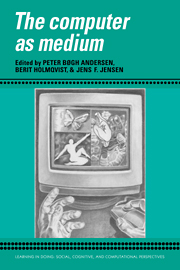Book contents
- Frontmatter
- Contents
- Series foreword
- Preface
- Contributors
- Part I Computer-based signs
- Introduction
- 1 A semiotic approach to programming
- 2 Structuralism, computation, and cognition: The contribution of glossematics
- 3 The shortest way between two points is a good idea: Signs, Peirce, and theorematic machines
- 4 Logic grammar and the triadic sign relation
- 5 Meaning and the machine: Toward a semiotics of interaction
- Part II The rhetoric of interactive media
- Part III Computers in context
- Index
3 - The shortest way between two points is a good idea: Signs, Peirce, and theorematic machines
Published online by Cambridge University Press: 05 October 2010
- Frontmatter
- Contents
- Series foreword
- Preface
- Contributors
- Part I Computer-based signs
- Introduction
- 1 A semiotic approach to programming
- 2 Structuralism, computation, and cognition: The contribution of glossematics
- 3 The shortest way between two points is a good idea: Signs, Peirce, and theorematic machines
- 4 Logic grammar and the triadic sign relation
- 5 Meaning and the machine: Toward a semiotics of interaction
- Part II The rhetoric of interactive media
- Part III Computers in context
- Index
Summary
The question to what extent a computer can think is an often recurring one that, owing to the quick shift in generations within the computer sciences, continues to be of relevance, although there is no real reason to expect an unequivocal answer. It can, however, be moderated to – to what extent can computers learn to think? Were we to bide our time, would it not be possible to make a machine that could stand comparison to human thinking? Or we could choose to ask ourselves: What is common to machinal and human reasoning? From which follows the closely related questions: Can computers dream? Can they discover, feel, error, lie, get good ideas? Can they develop or mature? Have they ethics, morals, aesthetic judgement, fantasy, intuition? And, last but not least, can they distinguish between differences that make a difference, and differences that do not?
Regardless of how one chooses to address these interrelated questions, the various answers that will ensue allow us to distinguish on the one hand between the cultural or developmental pessimists, who are convinced that machines are on the verge of a take-over and, on the other, the cultural optimists, whose view is that machines will continue to be but an ancillary instrument for human thought.
- Type
- Chapter
- Information
- The Computer as Medium , pp. 92 - 103Publisher: Cambridge University PressPrint publication year: 1994



